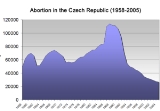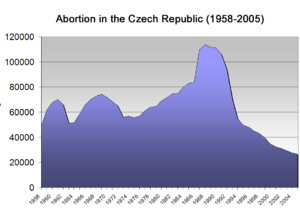
Abortion in the Czech Republic
Encyclopedia
Abortion in the Czech Republic is legally allowed up to 12 weeks of pregnancy
, with medical indications up to 24 weeks of pregnancy, in case of grave problems with fetus
at any time. Those performed for medical indications are covered by public health insurance, but, otherwise abortion
is relatively affordable in the Czech Republic
. In Czech
, induced abortion is referred to as interupce or umělé přerušení těhotenství, often incorrectly potrat ("miscarriage").
 In 1957 abortions were legalized in Czechoslovakia
In 1957 abortions were legalized in Czechoslovakia
, although with restrictions that depended on the current policy of the government
. In 1986 the restrictions were lifted resulting in growth of the number of abortions. Since 1993, abortions for non-medical reasons have not been paid for by the public health system. The absolute peak of the number of abortions was reached in 1990 at over 100,000 per year, but has declined steadily down since then, reaching less than 1/3 of the peak level in 2004. Reasons for this decrease have included the wider availability of contraception
s and better sex education
.
were aborted. Total abortions per woman is 0.53, induced abortions is 0.34.
Regionally, the highest abortion ratio is in northern and north-western Bohemia
due the structure of the population (in 2002 in Tachov District
31.3% of abortions were induced). The lowest ratios are in rural districts of southern Moravia
and Bohemian-Moravian Highlands
(in 2002 in Žďár nad Sázavou District
15.5% of abortions were induced). Abortion ratios in large industrial cities are generally higher compared to small towns and the countryside.
Married women form the largest segment but their ratio is decreasing in favour of unmarried young women. Women with tertiary level of education have about 6% of induced abortions. In 2009 7.5% of the women are foreigners living in the Czech Republic. Official statistics about abortion tourism (mainly from neighbouring Poland
where legal induced abortion is strictly limited) do not exist but the numbers are estimated to be low.
Pregnancy
Pregnancy refers to the fertilization and development of one or more offspring, known as a fetus or embryo, in a woman's uterus. In a pregnancy, there can be multiple gestations, as in the case of twins or triplets...
, with medical indications up to 24 weeks of pregnancy, in case of grave problems with fetus
Fetus
A fetus is a developing mammal or other viviparous vertebrate after the embryonic stage and before birth.In humans, the fetal stage of prenatal development starts at the beginning of the 11th week in gestational age, which is the 9th week after fertilization.-Etymology and spelling variations:The...
at any time. Those performed for medical indications are covered by public health insurance, but, otherwise abortion
Abortion
Abortion is defined as the termination of pregnancy by the removal or expulsion from the uterus of a fetus or embryo prior to viability. An abortion can occur spontaneously, in which case it is usually called a miscarriage, or it can be purposely induced...
is relatively affordable in the Czech Republic
Czech Republic
The Czech Republic is a landlocked country in Central Europe. The country is bordered by Poland to the northeast, Slovakia to the east, Austria to the south, and Germany to the west and northwest....
. In Czech
Czech language
Czech is a West Slavic language with about 12 million native speakers; it is the majority language in the Czech Republic and spoken by Czechs worldwide. The language was known as Bohemian in English until the late 19th century...
, induced abortion is referred to as interupce or umělé přerušení těhotenství, often incorrectly potrat ("miscarriage").
History

Czechoslovakia
Czechoslovakia or Czecho-Slovakia was a sovereign state in Central Europe which existed from October 1918, when it declared its independence from the Austro-Hungarian Empire, until 1992...
, although with restrictions that depended on the current policy of the government
Government
Government refers to the legislators, administrators, and arbitrators in the administrative bureaucracy who control a state at a given time, and to the system of government by which they are organized...
. In 1986 the restrictions were lifted resulting in growth of the number of abortions. Since 1993, abortions for non-medical reasons have not been paid for by the public health system. The absolute peak of the number of abortions was reached in 1990 at over 100,000 per year, but has declined steadily down since then, reaching less than 1/3 of the peak level in 2004. Reasons for this decrease have included the wider availability of contraception
Contraception
Contraception is the prevention of the fusion of gametes during or after sexual activity. The term contraception is a contraction of contra, which means against, and the word conception, meaning fertilization...
s and better sex education
Sex education
Sex education refers to formal programs of instruction on a wide range of issues relating to human sexuality, including human sexual anatomy, sexual reproduction, sexual intercourse, reproductive health, emotional relations, reproductive rights and responsibilities, abstinence, contraception, and...
.
Statistics
Total number of abortions in 2009 was 40 528 of which 14 629 (i.e. 3.1 %) were spontaneous abortions, 24 636 (60,79 %) induced abortions (historically the lowest number ever) of which 77% were "mini-interruptions" (within 8 weeks of pregnancy). 1,300 ectopic pregnanciesEctopic pregnancy
An ectopic pregnancy, or eccysis , is a complication of pregnancy in which the embryo implants outside the uterine cavity. With rare exceptions, ectopic pregnancies are not viable. Furthermore, they are dangerous for the parent, since internal haemorrhage is a life threatening complication...
were aborted. Total abortions per woman is 0.53, induced abortions is 0.34.
Regionally, the highest abortion ratio is in northern and north-western Bohemia
Bohemia
Bohemia is a historical region in central Europe, occupying the western two-thirds of the traditional Czech Lands. It is located in the contemporary Czech Republic with its capital in Prague...
due the structure of the population (in 2002 in Tachov District
Tachov District
Tachov District is a district within Plzeň Region of the Czech Republic. Its capital is Tachov.- Complete list of municipalities :Benešovice -Bezdružice -Bor -Brod nad Tichou -Broumov -Částkov -Cebiv -Černošín -...
31.3% of abortions were induced). The lowest ratios are in rural districts of southern Moravia
Moravia
Moravia is a historical region in Central Europe in the east of the Czech Republic, and one of the former Czech lands, together with Bohemia and Silesia. It takes its name from the Morava River which rises in the northwest of the region...
and Bohemian-Moravian Highlands
Bohemian-Moravian Highlands
The Bohemian-Moravian Highlands is an extensive range of hills and low mountains over long, which runs in a northeasterly direction across the Czech Republic and forms the border between Bohemia and Moravia...
(in 2002 in Žďár nad Sázavou District
Ždár nad Sázavou District
Žďár nad Sázavou District is a district within the Vysočina Region of the Czech Republic. Its capital is Žďár nad Sázavou, a town of 24,000 inhabitants built on the river Sázava...
15.5% of abortions were induced). Abortion ratios in large industrial cities are generally higher compared to small towns and the countryside.
Married women form the largest segment but their ratio is decreasing in favour of unmarried young women. Women with tertiary level of education have about 6% of induced abortions. In 2009 7.5% of the women are foreigners living in the Czech Republic. Official statistics about abortion tourism (mainly from neighbouring Poland
Poland
Poland , officially the Republic of Poland , is a country in Central Europe bordered by Germany to the west; the Czech Republic and Slovakia to the south; Ukraine, Belarus and Lithuania to the east; and the Baltic Sea and Kaliningrad Oblast, a Russian exclave, to the north...
where legal induced abortion is strictly limited) do not exist but the numbers are estimated to be low.
Public opinion
The public in the Czech Republic generally supports the legality of abortion. This has been confirmed by a number of opinion polls.- An April 2003 CDCCenters for Disease Control and PreventionThe Centers for Disease Control and Prevention are a United States federal agency under the Department of Health and Human Services headquartered in Druid Hills, unincorporated DeKalb County, Georgia, in Greater Atlanta...
/ORC Macro report examined opinions on abortion among women aged 15 to 44, asking, "Do you think that a woman always has the right to decide about her pregnancy, including whether to have an abortion?" In 1993, 85% of Czechs surveyed thought a woman always had the right to an abortion and 15% did not. Of those 15%, 91% believed abortion was acceptable in cases of life endangerment, 74% in cases of fetal defects, 72% in cases of risk to health, 71% in cases of rape, 16% if the family could not financially support a child, and 8% if the woman was unmarried. - A May 2005 Euro RSCGEuro RSCGEuro RSCG Worldwide is one of the largest integrated marketing communications agencies in the world, made up of 233 offices located in 75 countries throughout Europe, North America, Latin America, Asia Pacific and the Middle East. Euro RSCG provides advertising, marketing services, corporate...
/TNS SofresTaylor Nelson SofresTaylor Nelson Sofres is a leading market research and market information group. Formerly listed on the London Stock Exchange and a constituent of the FTSE 250 Index, the firm was acquired by WPP Group in October 2008 for 1.6 billion pounds.-History:...
poll examined attitudes toward abortion in 10 EuropeEuropeEurope is, by convention, one of the world's seven continents. Comprising the westernmost peninsula of Eurasia, Europe is generally 'divided' from Asia to its east by the watershed divides of the Ural and Caucasus Mountains, the Ural River, the Caspian and Black Seas, and the waterways connecting...
an countries, asking polltakers whether they agreed with the statement, "If a woman doesn't want children, she should be allowed to have an abortion". 66% of Czechs replied "very much", 15% replied "a little", 8% replied "not really", and replied 10% "not at all". Support for the availability of abortion in the Czech Republic, at 81%, was the highest out of all the nations featured in the poll. - A May 2007 CVVM poll found that 72% of Czechs believe that abortion should be allowed "at the request of the woman", 19% that it should be allowed for "societal reasons", 5% that it should be allowed only if "a woman’s health is at risk", 1% that it should be "banned".
See also
- AbortionAbortionAbortion is defined as the termination of pregnancy by the removal or expulsion from the uterus of a fetus or embryo prior to viability. An abortion can occur spontaneously, in which case it is usually called a miscarriage, or it can be purposely induced...
- Abortion by country
- Abortion lawAbortion lawAbortion law is legislation and common law which pertains to the provision of abortion. Abortion has been a controversial subject in many societies through history because of the moral, ethical, practical, and political power issues that surround it. It has been banned frequently and otherwise...
- Abortion debateAbortion debateThe abortion debate refers to discussion and controversy surrounding the moral and legal status of abortion. The two main groups involved in the abortion debate are the self-described "pro-choice" movement and the "pro-life" movement...
- Religion and abortionReligion and abortionMany religious traditions have taken a stance on abortion, and these stances span a broad spectrum as highlighted below.-Buddhism:There is no single Buddhist view concerning abortion. Traditional sources, such as the Buddhist monastic code, hold that life begins at conception and that abortion,...
External links
(all texts in Czech language)- Legal details
- Abortion statistics: overview, detailed.
- Text of current abortion law (PDF)

